|
 by
Craig Lemon
Hatchery Superintendent
The 2004 spring
trap-netting season proved very successful as hatchery and fisheries lab staff
collected large numbers of “trophy-quality” fish to serve as brood stock
at the Hackettstown State Fish Hatchery. These fish
lived up to expectations and produced plenty of eggs for this year’s stocking
needs. The fish were netted from various lakes and reservoirs and transported
back to the hatchery for egg collection. Millions of eggs from northern pike,
walleye and muskellunge adults were taken between March 11 and April 23. Actually,
this year’s brood stock collection season kicked off two weeks earlier than
2003 due to the ice melting off Budd Lake (Morris County) in early March.
|
Highlights
this year include the capture of three female walleyes weighing more than 10 pounds
each from Swartswood
Lake in Sussex County. In fact, one of them equaled the current state record
of 13 pounds, 10 ounces!
A muskellunge
measuring 50.4 inches was netted from Echo Lake Reservoir in Passaic County
along with 25 other nice-sized muskies. Fisheries lab crews also collected muskellunge
broodstock from Mercer Lake in Mercer County for the first time since muskies
were introduced there in September of 1998. The largest of these muskies weighed
an amazing 25.4 pounds -- it attained this size in only five growing seasons!
Following
are summaries of the netting activities for each species collected:
|
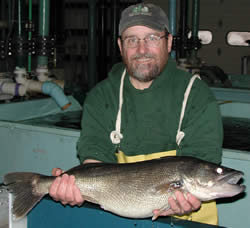 Steve
Strodel with walleye broodstock
Steve
Strodel with walleye broodstock |
Northern
Pike
Three
large trapnets and one smaller net were set in Budd Lake on March 11. Water temperatures
ranged from 34° to 39°F during the following 11-day netting period. The
nets were checked six times over that period, yielding 171 northern pike.
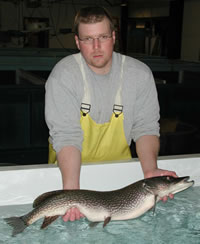 Ed
Conley with northern pike
Ed
Conley with northern pike |
Of
these, 149 were transported back to the hatchery where eggs were collected as
well as length, weight, sex and age (scale sample) measurements. Such information
is crucial to helping biologists evaluate the condition of the lake’s northern
pike population. The sex ratio was 4:1, 120 males to 29 females.
Eighteen of the 29 females were spawned and yielded a total of 450,415 eggs. The
females averaged 25,023 eggs per fish compared with 31,157 in 2003 and 35,000
in 2002. The decrease in eggs per female is due to the fact that six of the 18
had lost some of their eggs in the nets prior to arriving at the hatchery.
The
2004 Budd Lake numbers proved very similar to the 2003 totals. A total of 171
fish were captured in 2004 compared to 183 in 2003. This year’s males averaged
21.4" compared to 21.7" in 2003, while the females averaged 26.9"
compared to 26.4" in 2003. The largest fish was a female weighing 11.1 pounds
and measuring 34.2 inches. |
All
of the adult northerns were safely returned to Budd Lake after egg collection.
The eggs hatched after a 10-day incubation period and the fry were grown on a
high-protein, dry pellet diet to 7-inch fingerlings for stocking in early July.
Regional fisheries biologists have requested a total of 25,000 northern fingerlings
for stocking in the following waters: Cranberry
Lake (Sussex County), Pompton Lake (Passaic County), Spruce
Run Reservoir (Hunterdon County), Pompton River, Budd Lake, Farrington Lake
(Middlesex County), Millstone River and the Passaic River.
Walleye
|
The
Hackettstown Hatchery crew set one large and one small trapnet in Swartswood Lake
on March 24. Water temperatures ranged from 42° to 47°F during the netting
period. The nets were checked daily March 25-29. Daily checking was necessary
due to the large number of fish per net and the condition of the females (full
of eggs).
Walleye
females exhibit a tendency to release their eggs in the trapnets if not removed
promptly. The walleye spawning run was in full swing and produced an amazing 320
fish over a five-day period. This compared to 303 and 183 walleye captured in
11-day netting sessions in 2002 and 2003, respectively.
Of
the 320 walleye captured, 101 were females and the hatchery crew spawned 71 of
them producing 6.4 million eggs. The spawned females averaged 90,215 eggs per
fish compared to 70,000 eggs each in 2003. The considerably higher eggs per female
this year can be attributed to two things. |
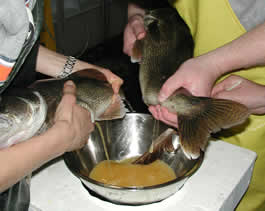
Stripping
walleyes and fertilizing eggs in basin |
First,
this year’s females averaged more than a half-pound and a full inch larger
than last year’s fish: 4.3 pounds and 21.2 inches in 2004 versus 3.7 pounds
and 20.2 inches in 2003. Second, the Swartswood Lake trapnets produced the two
largest walleyes ever captured in Division nets.
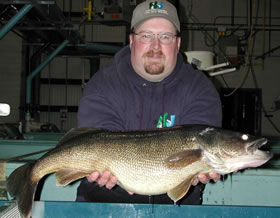
Craig Lemon with trophy walleye |
On April 28, hatchery staff netted a 12.3 pound, 29-inch gravid female (full of
eggs) and the following day netted a 13.6 pound, 29.8-inch gravid female from
the same net. The latter fish equaled the current New Jersey State record of 13
pounds 9 ounces taken from the Delaware River in 1993! All of the broodstock were
released safely back into Swartswood Lake shortly after egg collection.
Walleyes
were also captured from Greenwood Lake (Passaic County) March 30-April 21. These
nets were originally set to target muskellunge broodstock. Growth data (length,
weight, age) was collected at the hatchery from 27 of the 123 adult walleye that
were captured. The Greenwood Lake females averaged 5.5 pounds and 22.8 inches,
while the males averaged 2.3 pounds and 18.6 inches. |
Walleye
eggs take 13 days to hatch with a hatching rate of 40 to 70 percent. The first
million fry to hatch are placed in hatchery ponds and are grown to a size of two
inches on a diet of plankton. In 2003, a total of 376,000 of these 2-inch walleye
fingerlings were stocked into Greenwood Lake, Monksville Reservoir (Passaic County),
Lake Hopatcong (Morris County) and the Delaware River. The hatchery set up another
75,000 of these 2-inch pond fingerlings and continued growing them on a fathead
minnow diet. About one third or 28,000 of these two-inch fish reached the target
size of four-inches and were float stocked in Canistear Reservoir (Sussex County),
Lake Hopatcong, Swartswood Lake and Greenwood Lake.
Muskellunge
Trapnets
were set in Mercer Lake March 29-April 2. This undertaking accomplished two important
objectives. The first was to provide the hatchery with 290,000 muskellunge eggs.
Incidentally, these eggs were taken about two weeks earlier than the muskie eggs
collected from the state’s northern waters. This technique allows hatchery
staff to raise these fish right along with the pike and the pike/muskellunge hybrid
known as tiger muskies.
|
Since
all three species are tiny yet, water quality in the tank stays high since less
food is needed. This is important because more feed means increased ammonia levels
in the tank, which can be harmful to the growing fish. The second objective was
to provide regional biologists with valuable growth data to help them evaluate
the condition of the muskellunge population in Mercer Lake.
The
Mercer Lake trapnets captured a total of 19 muskellunge and one tiger muskie.
Of the 19 muskies, eight were females producing 289,000 eggs. The largest true-strain
muskie collected from Mercer was a ripe female weighing 25.4 pounds and measuring
42.3 inches. The one tiger muskie captured weighed 11.1 pounds and measured 37
inches (the tiger muskie is a cross between a muskellunge and a northern pike).
Tigers were stocked in Mercer Lake from 1989 to 1997. Back at the hatchery, one
of the Mercer Lake female muskies was spawned with several male northern pike
from Budd Lake and the combination produced 36,000 tiger muskie eggs. |
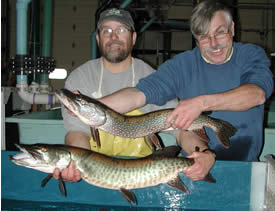 Northern
pike (top) and muskellunge used to produce tiger muskie hybirds
Northern
pike (top) and muskellunge used to produce tiger muskie hybirds |
Trapnets
targeting muskellunge were also placed in Greenwood Lake March 30-April 21. Disappointingly,
three large nets produced only 10 muskies over the three-week period. Water temperatures
remained very cold, hovering between 38° and 44°F for most of the netting
period. Those cold water temperatures are believed to be the cause of the low
catch rates. However, water temperatures warmed into the 50s toward the end of
the netting period and catch rates improved. The largest fish captured was an
egg-laden female weighing 20.7 pounds and measuring 44.8 inches.
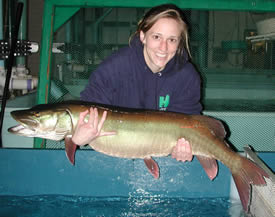 Allison
Byrd with large muskellunge
Allison
Byrd with large muskellunge |
Finally,
trapnets were set in Echo Lake Reservoir April 13-19. Just the opposite of Greenwood
Lake, the Echo nets produced 26 muskies in just under a week. Water temperatures
ranged from 45° to 54°F; perfect for spawning muskellunge. Of the 26 muskies
captured, 16 were females and 10 of these females arrived at the hatchery full
of eggs.
These
Echo Lake females (of the "Leech Lake” strain) contributed a large portion
of the 1.2 million muskie eggs taken by hatchery staff in April. This strain originated
from Leech Lake in Minnesota and was brought into New Jersey when Muskies,
Inc. Chapter 22 purchased fingerlings in 1991 for stocking in Echo Lake.
Amazingly, one net caught 10 muskies in a 24-hour period on the boat ramp end
of the lake. One of the ten turned out to be the first 50 inch muskie the hatchery has ever captured there. It measured 50.4 inches and weighed 31.5 pounds and was a “Leech Lake” strain muskellunge. |
This year's
muskie eggs hatched at a rate of 59%, producing about 500,000 fry. These fry will
be split between indoor and outdoor growing techniques. Half will be earmarked
for intensive indoor tank culture, while the others will be placed outside for
extensive pond culture.
In
2003, the hatchery raised 8,550 muskie fingerlings ranging between seven and 12
inches for stocking in the following waters: Echo Lake Reservoir, Lake
Hopatcong, Mercer Lake, Mountain Lake (Warren County), Greenwood Lake, Carnegie
Lake (Middlesex County), Manasquan Reservoir (Monmouth County), Deal Lake (Monmouth County) and the Delaware River.
Conclusions
|
The
2004 trapnetting season lasted a month and a half. It was a very successful six
weeks with some tremendous trophy-sized fish captured, spawned and safely returned
to our lakes and reservoirs.
As
a hatchery supervisor who started 17 years ago as a seasonal worker, it is unbelievably
rewarding to witness the programs created through the dedication and devotion
of fisheries staff in the New Jersey Division of Fish and Wildlife. The stocking
efforts of some very active fishing clubs have also helped pave the way for some
of these great success stories. The crew at the Hackettstown Hatchery did a tremendous
job dealing with the harshness of Mother Nature this spring since the nets had
to be checked daily, regardless of snow, rain, sleet or high winds.
Currently,
all the eggs have hatched and the fish are in excellent condition. The hatchery
has stocked some excess fingerlings in the Passaic River (northern pike) and the
Delaware River (tiger muskellunge). In addition, the West Virginia Department
of Natural Resources made a trip to the Hackettstown facility in April and picked
up 14,000 small fingerling (northern pike) as part of a unique inter-state fish
exchange program. Meanwhile, the northern pike have grown to 4 inches, tiger muskies
to 2 inches and the muskies are now about 1-inch long. The one million walleye
fry put into three hatchery ponds are just under one-inch in length. About one
million walleye fry were also split between Lake Hopatcong and Greenwood Lake.
|
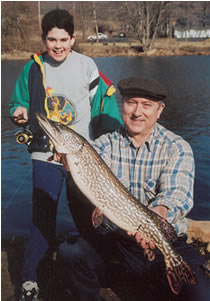 What it's all about - pike caught at Spruce Run.
What it's all about - pike caught at Spruce Run.
Photo by Tom Pagliaroli |
Keep
your eyes out for any tagged muskellunge in Mercer Lake and Echo Lake. The hatchery
has tagged about 50 adult muskies with numbered, orange streamer tags. Each tag
has an individual number plus the phone number for the Hackettstown Hatchery. We are hoping to get some valuable information about our muskellunge population and its health from the information reported by the angling public.
These tagged fish have been back in the water for only a few weeks and the hatchery
has had three reports already from successful anglers. Many anglers practice catch
and release on these muskellunge making it possible for data to be received for
many years to come. Stay tuned to the Hackettstown
Hatchery-related pages of the Division’s website for further updates
on the progress of this year’s fingerlings, and best wishes for future fishing
success!
NORTHERN
PIKE
|
WATER BODY
|
# DAYS NETS WERE SET
|
# FISH CAUGHT
|
AVERAGE LENGTH (INCHES)
|
LARGEST FISH (INCHES)
|
AVERAGE WEIGHT (POUNDS)
|
LARGEST FISH (POUNDS)
|
|
BUDD LAKE
|
11
|
171
|
22.5
|
34.2
|
2.79
|
11.1
|
MUSKELLUNGE
|
WATER BODY
|
# DAYS NETS WERE SET
|
# FISH CAUGHT
|
AVERAGE LENGTH (INCHES)
|
LARGEST FISH (INCHES)
|
AVERAGE WEIGHT (POUNDS)
|
LARGEST FISH (POUNDS)
|
|
ECHO LAKE RESERVOIR
|
10
|
26
|
40.1
|
50.4
|
15.0
|
31.5
|
|
GREENWOOD LAKE
|
21
|
21
|
39.1
|
44.8
|
14.7
|
20.7
|
|
MERCER LAKE
|
5
|
19
|
34.3
|
42.3
|
11.5
|
25.4
|
WALLEYE
|
WATER BODY
|
# DAYS NETS WERE SET
|
# FISH CAUGHT
|
AVERAGE LENGTH (INCHES)
|
LARGEST FISH (INCHES)
|
AVERAGE WEIGHT (POUNDS)
|
LARGEST FISH (POUNDS)
|
|
GREENWOOD LAKE
|
21
|
123
|
22.2
|
26.6
|
5.1
|
8.5
|
|
SWARTSWOOD LAKE
|
5
|
320
|
18.9
|
29.8
|
2.9
|
13.6
|
|







